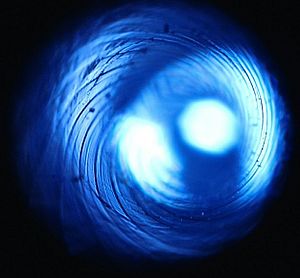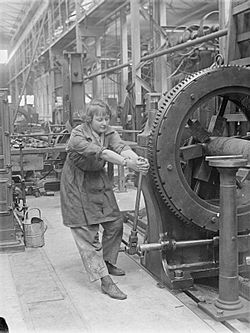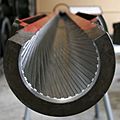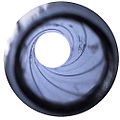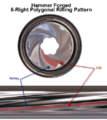Rifling facts for kids
Rifling means cutting spiral grooves inside a gun barrel. These grooves make the bullet or projectile spin as it flies. This spin helps the bullet fly straighter and hit targets better over long distances. The first guns to use this idea were called rifles.
Gun barrels can have a left or right twist. The "twist rate" tells you how many turns the bullet makes per inch. For example, a 1:7 twist means the bullet spins once every seven inches it travels in the barrel. Usually, heavier bullets need a faster twist rate to fly well.
Contents
History of Rifling
People think Gaspard Kollner, a gunmaker from the 1400s in Vienna, invented rifling. Others believe it was Augustus Kotter from Nuremberg around 1520. Around the same time, some crossbows fired bolts through spiral-grooved tubes for better flight. It's not clear which came first.
Early Guns and Muskets
The "hand cannon" first appeared in China in 1288. From these early guns, the smoothbore musket became common in Europe by the 1400s. Muskets couldn't fire as fast as an archer or be reloaded on horseback. However, they could shoot through armor. A big advantage of muskets was that anyone could learn to shoot one quickly. Training an archer took much longer.
The British army used muskets with pikemen until about 1705. In 1722, they started using a standard musket called the Brown Bess until the 1830s. Muskets fired a round ball that was smaller than the barrel. This meant the ball bounced around inside the barrel when fired. When it left the barrel, it could go in many directions, making the musket very inaccurate.
To make up for this, soldiers stood close together and fired in volleys (all at once). This sent many bullets generally towards the enemy. The idea was that some bullets would hit. The smoke from many volleys made it hard to see what they were shooting at. Sometimes, soldiers would not push the bullet and powder all the way down the barrel. This made the musket even less effective.
Rifles Change Warfare
The use of rifled muskets, called rifles, changed how battles were fought. During the American Revolutionary War, Americans used muskets. But they also had skilled shooters with their Kentucky rifles. These rifles had longer, rifled barrels for accuracy over long distances.
American riflemen started targeting British officers instead of just regular soldiers. Without their officers giving commands, British soldiers struggled to fight as a team. The British leaders disliked this tactic, calling it "unsportsmanlike." But the Americans kept doing it until the war ended.
The Minié Ball
In 1849, a French army officer named Claude-Étienne Minié invented a special bullet. It had a hollow base and was named the Minié ball. When fired, the Minié ball expanded to fit the rifling inside the gun barrel. This made it even more accurate over longer distances.
The British used it successfully in the Crimean War against Russian forces. During the American Civil War, both the Union and Confederate armies first used smoothbore muskets. But soon, rifled muskets using the Minié ball replaced them. This allowed armies to cause much more damage to their opponents from farther away.
How Rifling is Made
Most firearms made today have a rifled barrel. There are three main ways to make rifled barrels.
- Broach Rifling: This method uses a hard steel tool called a broach. The broach has several cutting rings, each slightly larger than the last. As it passes through the barrel, each ring cuts the grooves a little deeper. The raised parts left in the barrel after rifling are called lands.
- Button Rifling: This is the most common method. A very hard steel "button" is pushed through the unrifled barrel. The button has the shape of the rifling grooves. It cuts the grooves by using very high pressure. This process also makes the inside of the barrel very smooth.
- Hammer Forged Rifling: This method creates a type of rifling called "polygonal rifling." A special rod, called a mandrel, is put inside a barrel blank (a plain tube). Then, hammers hit the outside of the barrel. This makes the barrel smaller and forms the rifling around the mandrel. After the mandrel is removed, you have a rifled barrel. The last step is to smooth the outside of the barrel.
Images for kids
-
Conventional rifling of a 90 mm M75 cannon from 1891.
-
Russian 122 mm shrapnel shell showing rifling marks on its copper alloy driving band.
-
A Parrott rifle, used by both Confederate and Union forces in the American Civil War.
See also
 In Spanish: Ánima rayada para niños
In Spanish: Ánima rayada para niños


